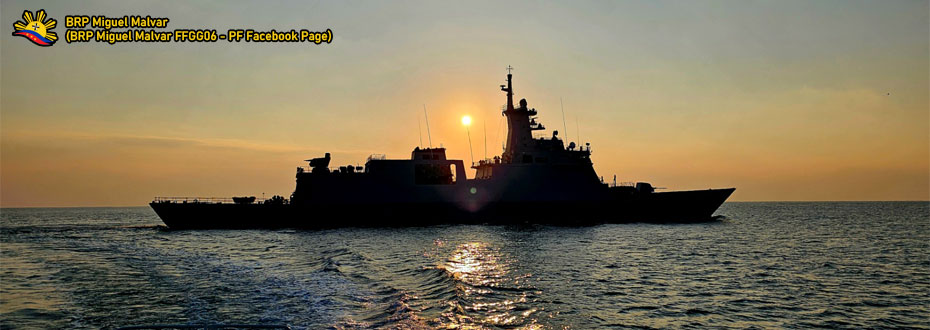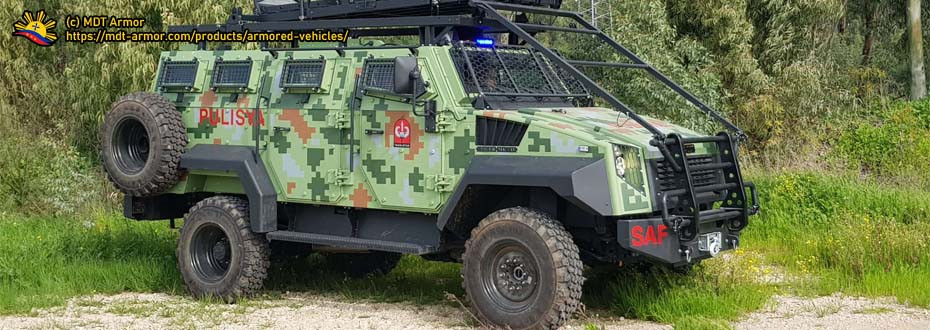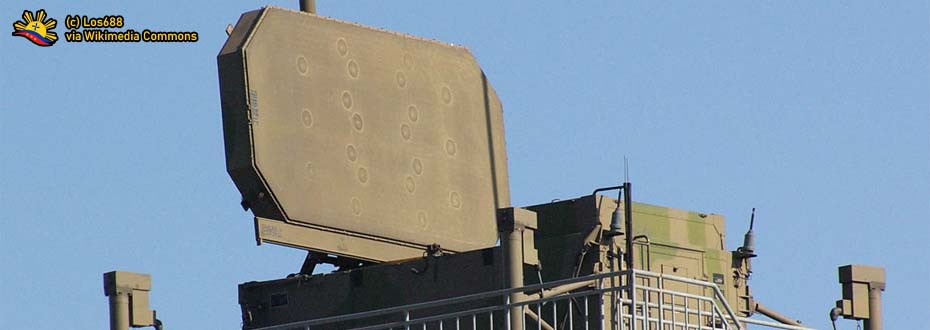The High Mobility Artillery Rocket System, or HIMARS as it is called, always comes with ways that will showcase its firepower capabilities, as it is in its design to saturate enemy targets with continuous bombardments of rocket artillery, while attaining its flexibility and mobility that stands to its abbreviation. The system’s show of immense firepower capabilities comes in at least two (2) instances that are about to be discussed in this article, with one being a bilateral exercise, while the other being an actual combat.
The first one comes with the multiple bilateral exercises that the United States Armed Forces have with their counterparts within the Armed Forces of the Philippines, such as the
annually conducted Balikatan Exercises (see image above) and the recently conducted Marine Aviation Support Activity Exercises or MASA 23, whereby the former showcases its capability of mobility by getting it onboard a military such as a C-130 Cargo Aircraft that the Philippine Air Force currently have in its inventory and has plans to get more.
It is through the first-ever Sinking Exercises that both the United States Military, and counterparts in the Armed Forces of the Philippines conducted, that the former used its High Mobility Artillery Rocket System (HIMARS) launchers as a platform for anti-ship operations. This comes as there are other platforms that are far more effective in sinking a target enemy warship outright, such as the
BrahMos coastal missile systems sought by both the
Philippine Army and the
Philippine Marine Corps (the latter actually bought them), and the
SSM-700K C-Star anti-ship missiles found aboard the Jose Rizal-class Frigates and soon, the HDC-3100 Corvettes.
While the HIMARS Launchers are less effective in targeting and sinking ships during the conduct of the Balikatan Exercises,
its capabilities came into its full function when used by defenders in the conflict that currently taking place in the Eastern part of Europe in the area that borders Russia, whereby the launchers and the munitions that came with it provided
significant gains to the Ukrainian defenders in targeting enemy positions as part of its ongoing war effort and the defense of their country.
As the leadership within the Philippine Army considering and possibly even pushing the acquisition of the High Mobility Artillery Rocket System or HIMARS for its own use as part of the government’s push for investing into external defense, let us discuss the specifications that came with this rocket system that the United States Armed Forces uses, comparing to other assets that this service branch once opted for like the
K-136 Kooryong Multiple-Launch Rocket System (MLRS).
SPECIFICATIONS
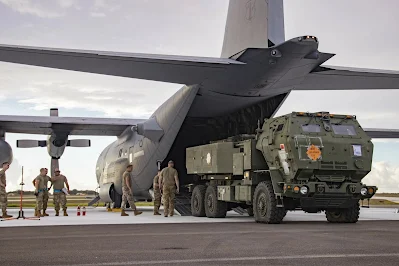 |
A HIMARS Launcher disembark from a C-130J Military Cargo Aircraft, showcasing its capability of getting in an aircraft for deployment.
Image Source. |
As the Philippine Army opts to have more modern Multiple-Launch Rocket System or MLRS into its own hands aside from having both its towed artillery and the ATMOS 2000 Self-Propelled Howitzer platforms that it currently possess, the understanding of HIMARS’ specifications also comes as the mentioned service branch considered other platforms like the
K-136 Kooryong MLRS from South Korea before getting to this point of considering the HIMARS as a preferred platform.
Speaking of comparing the K-136 Kooryong and the High Mobility Artillery Rocket System (HIMARS), it is clear from here that the latter comes with more modern subcomponents onboard and better firepower capabilities compared to the former, as the HIMARS came from development into its first production in the early 2000s as compared to the South Korean MLRS platform that have served their military
since the 1980s and may eventually get replaced by far more modern platforms like the K239 Chunmoo.
Regarding its specifications in-detail, the HIMARS Launcher truck alone weighs at around 10,886 kilograms or 10.88 tons, with its maximum road speed of around 85 kilometers per hour as its engine comes with either a
Caterpillar 3115 ATAAC 6.6-liter diesel engine or a
Caterpillar C7 engine coupled to a 7-speed automatic Allison 3700SP transmission. The said launcher truck comes usually as a
FMTV or a family of Medium Tactical Vehicles, itself being a 6x6 wheeled army truck that served as one of the mainstay cargo vehicles of the United States Military.
The launcher comes with two configurations. First is the
usual six (6) canisters that comes on a typical HIMARS Multiple-Launch Rocket System configuration with its munition coming with a rocket weight of 307 kilograms, its warhead being at 120 kilograms, and its caliber being at 227mm with an overall munition weight in six canisters coming at around 2,562 kilograms or 2.56 tons that adds to the weight of the launcher truck if fully loaded.
The second configuration is that the HIMARS Launchers have the capacity of carrying at least a single
MGM-140 ATACMS warhead, as this munition comes with an extra firepower option for a HIMARS user to consider and with the ATACMS missile can get launched in only two launcher options available, with the other platform being the
M270 MLRS of the United States Armed Forces.
Its firepower capability, plus its additional feature of getting delivered by a cargo aircraft like the C-130s that the Philippine Air Force currently has in its fleet and has plans in the future, makes the HIMARS a suitable option that the leadership within the Philippine Army to consider, whilst having an expensive price tag that limits the number of batteries that the organization may get while considering other options such as South Korea’s better option to the K-136 Kooryong it offers,
which is the K-239 Chunmoo MLRS.
TO SURMISE THINGS UP
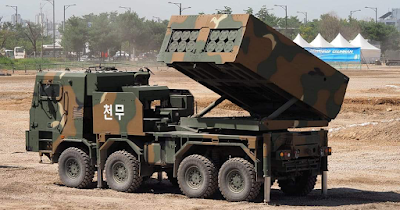 |
The Philippine Army also checks on other types of MLRS, such as South Korea’s K239 Chunmoo MLRS for its rocket artillery options.
Image Source. |
As the government gears itself into external defense, it is at no doubt that the Armed Forces of the Philippines, including the troops in the Philippine Army, are gearing themselves up into this new primary mission provided to the entire military as
counterinsurgency threats have gone down and more military hardware under the current Revised AFP Modernization Program are getting considered as tensions in the Indo-Pacific region brews up.
And with this gearing up also involves increasing involvement of the United States Armed Forces and their presence becoming more common with bilateral exercises
and additional sites under the
Enhanced Defense Cooperation Agreement, whereby they are now showcasing their best of military weaponry that the Philippine Armed Forces may consider, with the Philippine Army getting its eyes on the likes of the
FGM-148 Javelin anti-tank missiles and the High Mobility Artillery Rocket System or better known as HIMARS.
Both the FGM-148 Javelin and the HIMARS are products of Lockheed Martin’s Missiles and Fire Control Division, a part of Lockheed Martin company itself that specializes more on missiles and rocket technology that bears fruitful results, especially that both of the systems are actively in-use by Ukrainian defenders. This may count as another pitch of the U.S. based defense industry for the Philippine Armed Forces to consider, coming alongside C-130J Hercules Aircraft,
F-16 Multirole Fighter Jets, and the
S-70i Sikorsky Blackhawk Helicopters that the Philippine Air Force received.
Its reputable performance both within the United States Armed Forces and outside that actively uses the platform makes it viable for the Philippine Army to consider it alongside India’s BrahMos missile system, whereby this rocket artillery system comes as more modern and more sophisticated than the previously considered K-136 Kooryong Multiple-Launch Rocket System from South Korea,
as there is an information that these assets may no longer pursued in favor of the likes of HIMARS and similarly modern MLRS solutions like the Elbit Lynx PULS and the K239 Chunmoo (image above).
The High Mobility Artillery Rocket System or HIMARS comes with two options that the end-user may choose to get such capability, one of which being a capability of carrying and launching a single MGM-140 Army Tactical Missile System or the ATACMS Ground-to-ground missile munition, sufficient to destroy a ground target at a range of 300 kilometers that the likes of the BrahMos missiles that the Philippine Army also considers is capable of.
With the BrahMos missiles also being sought by the leadership, the HIMARS systems that the service branch may get will be the conventional one, with six rocket canisters filled with either a GMLRS or a ER-MLRS munitions solution that are both products of Lockheed Martin Missiles and Fire Control Division and may come as a package alongside the HIMARS Launchers provided, its truck design being a mainstay cargo vehicle within the United States Military..
To sum it up, the Philippine Army’s plan of having HIMARS in its inventory comes as a big boost in its firepower capability shall the plan pushes through, especially that the entire Armed Forces of the Philippines is now gearing itself up to uphold territorial defense and such systems now come as an essential part of that effort of making sure that the country has the minimum credible deterrence it needs.













